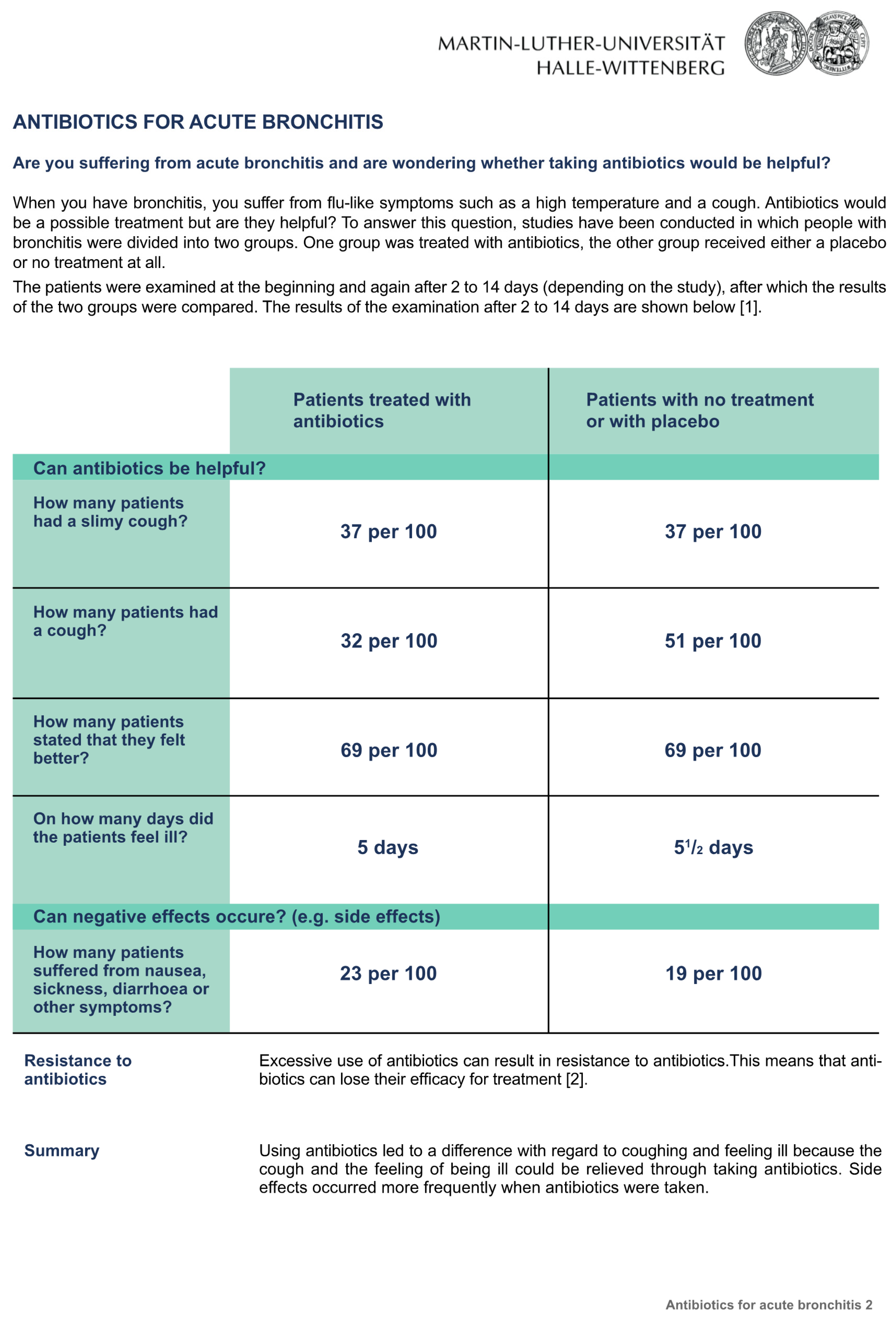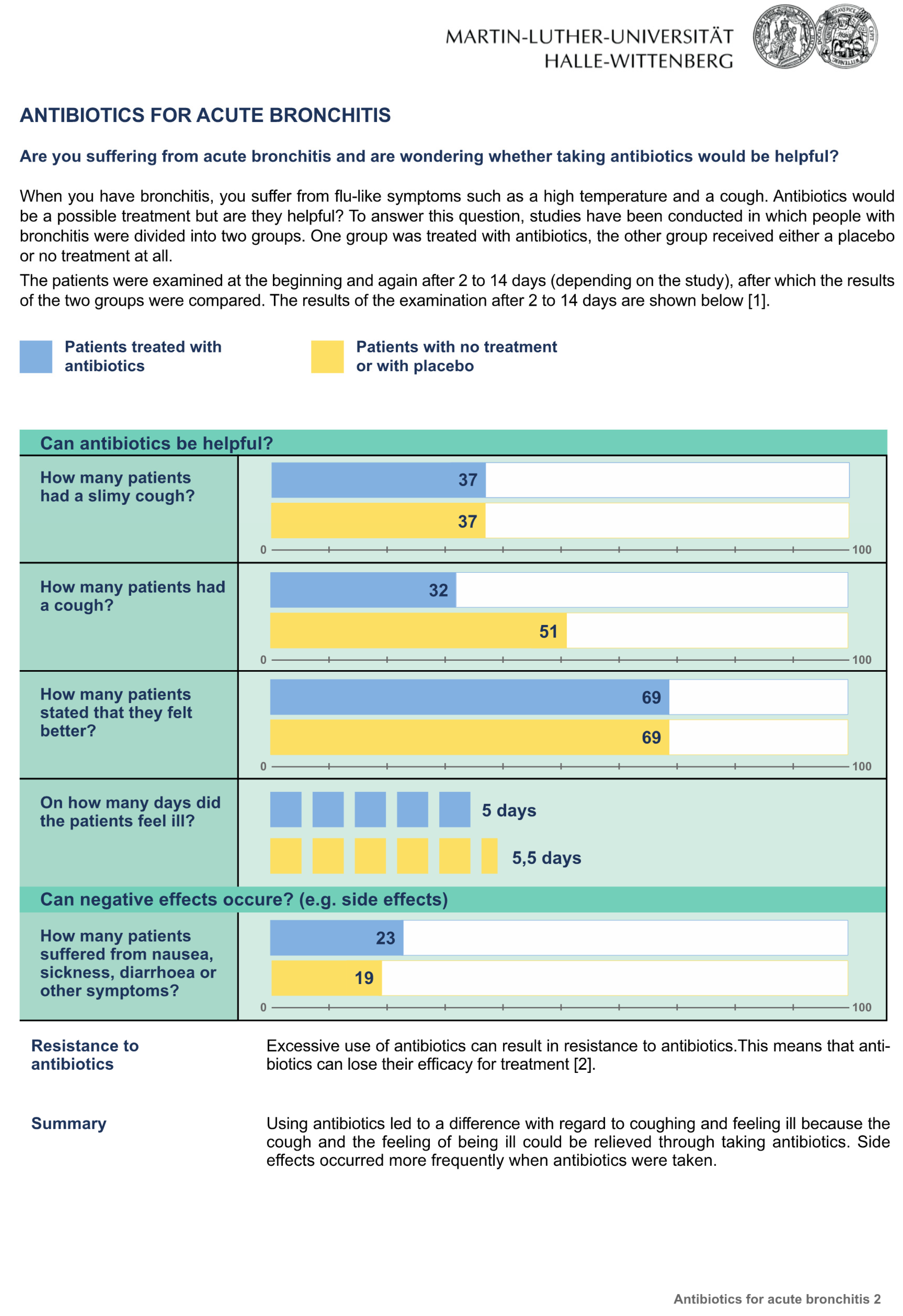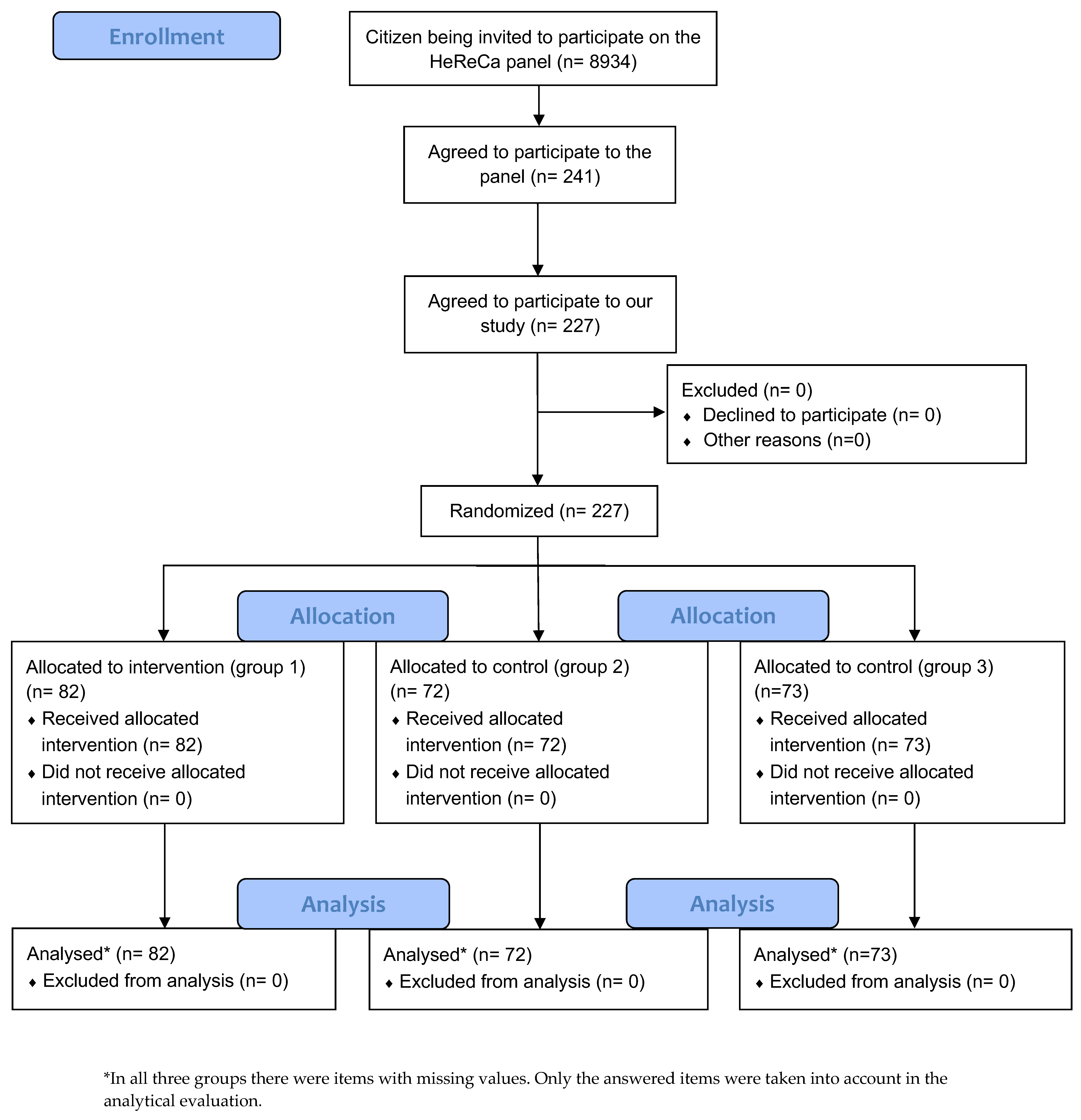Efficacy of Three Numerical Presentation Formats on Lay People’s Comprehension and Risk Perception of Fact Boxes—A Randomized Controlled Pilot Study
Abstract
1. Introduction
2. Materials and Methods
2.1. Design
2.2. Setting and Study Participants
2.3. Recruitment
2.4. Randomization and Blinding
2.5. Intervention and Control Intervention
2.6. Outcomes and Moderating Variables
- Verbatim and gist knowledge
- Readability/Comprehensibility
- Acceptance
- Relevance
- Moderating variables
2.7. Sample Size
2.8. Procedure of Data Collection
2.9. Data Analysis
- Trial registration: ISRCTN17033137: https://doi.org/10.1186/ISRCTN17033137. Date of registration: 06/04/2020.
3. Results
3.1. Primary Outcome
Verbatim and Gist Knowledge
3.2. Secondary Outcomes
3.2.1. Readability/Comprehensibility
3.2.2. Acceptance
3.2.3. Relevance
3.3. Knowledge by Educational Level
4. Discussion
Strengths and Limitations
5. Conclusions
Author Contributions
Funding
Institutional Review Board Statement
Informed Consent Statement
Data Availability Statement
Conflicts of Interest
Appendix A
| Verbatim Knowlege | ||||
| 37 * | |||
| 0 * | |||
| 37 * | |||
| 4 * | |||
| 5 * | |||
| 19 * | |||
| 0 * | |||
| 23 * | |||
| 19 * | |||
| Gist knowledge | ||||
| No, there is no difference (antibiotics/placebo) * | Yes, more people receiving antibiotics get a slimy cough | No, less people receiving antibiotics get a slimy cough | |
| Muscle pain | Diarrhoea * | Hair loss | Tiredness |
| Always | Frequently * | Less frequently | Never |
| Obesity | Addiction to antibiotics | High blood pressure | Resistance to antibiotics * |
| 0 day | 1/2 days * | 4 days | 7 days |
| Readability/Comprehensibility | ||||
| Very easy | Easy | Hardly easy at all | Not at all easy |
| Very easily understood | Easily understood | Hardly comprehensible | Completely incomprehensible |
| Very easy to read | Easy to read | Less easy to read | Difficult to read |
| Very easy to read | Easy to read | Less easy to read | Difficult to read |
| Acceptance | ||||
| Very attractive | Attractive | Less attractive | Disagreeable |
| Very trustworthy | Trustworthy | Less trustworthy | Not at all trustworthy |
| I agree absolutely | I agree | I tend not to agree | I do not agree at all |
| Relevance | ||||
| Extremely helpful | Helpful | Somewhat helpful | Not at all helpful |
References
- Kerschner, B.; Wipplinger, J.; Klerings, I.; Gartlehner, G. How evidence-based are print-and online mass media in Austria? A quantitative analysis. Z. Evidenz Fortbild. Qual. Gesundh. 2015, 109, 341–349. [Google Scholar] [CrossRef] [PubMed]
- Mühlhauser, I.; Albrecht, M.; Steckelberg, A. Evidence-based health information and risk competence. GMS Ger. Med. Sci. 2015, 13. [Google Scholar] [CrossRef]
- Bundesgesetzblatt. Patients’ Rights Act; Bundesanzeiger: Cologne, Germany, 2013; Volume 9, pp. 277–282. [Google Scholar]
- Lühnen, J.; Albrecht, M.; Mühlhauser, I.; Steckelberg, A. Guideline Evidence-Based Health Information. Hamburg 2017. Available online: https://www.leitlinie-gesundheitsinformation.de/?lang=en (accessed on 15 August 2019).
- Hinneburg, J.; Wilhelm, C.; Ellermann, C. Methodenpapier für Die Entwicklung von Faktenboxen. Potsdam: Harding-Zentrum für Risikokompetenz. 2020. Available online: https://www.hardingcenter.de/sites/default/files/2021-06/Methodenpapier%20des%20Harding-Zentrums_DE_20210616_final_0.pdf (accessed on 23 December 2022).
- Schwartz, L.M.; Woloshin, S.; Welch, H.G. Using a Drug Facts Box to Communicate Drug Benefits and Harms. Ann. Intern. Med. 2009, 150, 516–527. [Google Scholar] [CrossRef] [PubMed]
- Schwartz, L.M.; Woloshin, S.; Welch, H.G. The drug facts box: Providing consumers with simple tabular data on drug benefit and harm. Med. Decis. Mak. 2007, 27, 655–662. [Google Scholar] [CrossRef]
- Aikin, K.J.; O’Donoghue, A.C.; Swasy, J.L.; Sullivan, H.W. Randomized Trial of Risk Information Formats in Direct-to-Consumer Prescription Drug Advertisements. Med. Decis. Mak. 2011, 31, E23–E33. [Google Scholar] [CrossRef]
- Brick, C.; McDowell, M.; Freeman, A.L.J. Risk communication in tables versus text: A registered report randomized trial on ‘fact boxes’. R. Soc. Open Sci. 2020, 7, 190876. [Google Scholar] [CrossRef]
- Harding-Zentrum für Risikokompetenz. Antibiotika bei Akuter Bronchitis. 2019. Available online: https://www.harding-center.mpg.de/de/faktenboxen/antibiotika/akute-bronchitis (accessed on 4 August 2019).
- ertelsmann Stiftung. Faktenbox Antibiotika bei akuter Bronchitis. Nutzen und Risiken im Überblick. 2019. Available online: https://www.weisseliste.de/export/sites/weisseliste/de/.content/pdf/service/Faktencheck_Antibiotika_Faktenbox_akute_Bronchitis.pdf (accessed on 28 August 2019).
- Tait, A.R.; Voepel-Lewis, T.; Zikmund-Fisher, B.; Fagerlin, A. The Effect of Format on Parents’ Understanding of the Risks and Benefits of Clinical Research: A Comparison between Text, Tables, and Graphics. J. Health Commun. 2010, 15, 487–501. [Google Scholar] [CrossRef]
- Ruiz, J.G.; Andrade, A.D.; Garcia-Retamero, R.; Anam, R.; Rodriguez, R.; Sharit, J. Communicating global cardiovascular risk: Are icon arrays better than numerical estimates in improving understanding, recall and perception of risk? Patient Educ. Couns. 2013, 93, 394–402. [Google Scholar] [CrossRef]
- Brewer, N.T.; Gilkey, M.B.; Lillie, S.; Hesse, B.; Sheridan, S.L. Tables or Bar Graphs? Presenting Test Results in Electronic Medical Records. Med. Decis. Mak. 2012, 32, 545–553. [Google Scholar] [CrossRef]
- Tait, A.R.; Voepel-Lewis, T.; Brennan-Martinez, C.; McGonegal, M.; Levine, R. Using Animated Computer-generated Text and Graphics to Depict the Risks and Benefits of Medical Treatment. Am. J. Med. 2012, 125, 1103–1110. [Google Scholar] [CrossRef]
- Zikmund-Fisher, B.J.; Ubel, P.A.; Smith, D.M.; Derry, H.A.; McClure, J.B.; Stark, A.; Pitsch, R.K.; Fagerlin, A. Communicating side effect risks in a tamoxifen prophylaxis decision aid: The debiasing influence of pictographs. Patient Educ. Couns. 2008, 73, 209–214. [Google Scholar] [CrossRef] [PubMed]
- McDowell, M.; Gigerenzer, G.; Wegwarth, O.; Rebitschek, F.G. Effect of Tabular and Icon Fact Box Formats on Comprehension of Benefits and Harms of Prostate Cancer Screening: A Randomized Trial. Med. Decis. Mak. 2018, 39, 41–56. [Google Scholar] [CrossRef] [PubMed]
- Aubertin, P.; Hinneburg, J.; Hille, L.; Steckelberg, A. Fact Boxes: What gets through? A focus group study. Z. Evidenz Fortbild. Qual. Gesundh. 2022, 168, 96–105. [Google Scholar] [CrossRef]
- Way, D.; Blazsin, H.; Löfstedt, R.; Bouder, F. Pharmaceutical Benefit–Risk Communication Tools: A Review of the Literature. Drug Saf. 2016, 40, 15–36. [Google Scholar] [CrossRef]
- Schulz, K.F.; Altman, D.G.; Moher, D.; CONSORT Group. Consort 2010 Statement: Updated guidelines for reporting parallel group randomized trials. Ann. Int. Med. 2010, 152, 726–732. [Google Scholar] [CrossRef]
- Martin Luther University. Drug Fact Box Antibiotics for Acute Bronchitis. Available online: https://www.medizin.uni-halle.de/fileadmin/Dokumente/Dokumente/Institut_GPW/Forschung/Faktenbox_MLU_Bronchitis_englisch_2022.pdf (accessed on 15 June 2019).
- Marteau, T.M.; Dormandy, E.; Michie, S. A measure of informed choice. Health Expect. 2001, 4, 99–108. [Google Scholar] [CrossRef]
- Steckelberg, A.; Hülfenhaus, C.; Haastert, B.; Mühlhauser, I. Effect of evidence based risk information on “informed choice” in colorectal cancer screening: Randomised controlled trial. BMJ 2011, 342, d3193. [Google Scholar] [CrossRef]
- General Medical Council. Consent: Patients and Doctors Making Decisions Together. Available online: http://www.gmc-uk.org/guidance/ethical_guidance/consent_guidance_contents.asp (accessed on 14 January 2023).
- Lühnen, J.; Albrecht, M.; Mühlhauser, I.; Steckelberg, A. Leitlinienreport zur “Leitlinie evidenzbasierte Gesundheitsinformation”. Hamburg 2017. Available online: http://www.leitlinie-gesundheitsinformation.de/ (accessed on 24 December 2022).
- Sauer, C. Ein Minimalmodell zur Verständlichkeitsanalyse und -optimierung. Spillner Bernd (Hg.) Sprache: Verstehen und Verständlichkeit. Kongressbeiträge zur 1995, 25, 149–171. [Google Scholar]
- Thabane, L.; Ma, J.; Chu, R.; Cheng, J.; Ismaila, A.; Rios, L.P.; Robson, R.; Thabane, M.; Giangregorio, L.; Goldsmith, C.H. A tutorial on pilot studies: The what, why and how. BMC Med. Res. Methodol. 2010, 10, 1. [Google Scholar] [CrossRef]
- Danya, H.; Yonekura, Y.; Nakayama, K. Effects of graphic presentation on understanding medical risks and benefits among Japanese adults. Cogent Med. 2021, 8, 1907894. [Google Scholar] [CrossRef]
- Carmona, C.; Crutwell, J.; Burnham, M.; Polak, L. Shared decision-making: Summary of NICE guidance. BMJ 2021, 373, n1430. [Google Scholar] [CrossRef] [PubMed]
- Mata, J.; Dieckmann, A.; Gigerenzer, G. Verständliche Risikokommunikation, leicht gemacht-Oder: Wie man verwirrende Wahrscheinlichkeitsangeben vermeidet. ZFA-Z. Für Allg. 2005, 81, 537–541. [Google Scholar] [CrossRef]
- University of Cambridge. Predict Breast Cancer. Available online: https://breast.predict.nhs.uk/tool (accessed on 1 April 2022).
- Farmer, G.D.; Pearson, M.; Skylark, W.J.; Freeman, A.L.J.; Spiegelhalter, D.J. Redevelopment of the Predict: Breast Cancer website and recommendations for developing interfaces to support decision-making. Cancer Med. 2021, 10, 5141–5153. [Google Scholar] [CrossRef] [PubMed]
- Higgins, J.P.T.; Savović, J.; Page, M.J.; Sterne, J.A.C. Revised Cochrane Risk-of-Bias Tool for Randomized Trials (RoB 2). 2019. Available online: https://drive.google.com/file/d/19R9savfPdCHC8XLz2iiMvL_71lPJERWK/view (accessed on 3 July 2021).
- Statista. Proportion of Internet Users According to Age Groups in Germany from 2014 to 2020. 2020. Available online: https://de.statista.com/statistik/daten/studie/3101/umfrage/internetnutzung-in-deutschland-nach-altersgruppen/ (accessed on 24 June 2021).






| Fact Box | Fact Box | Fact Box | |
|---|---|---|---|
| Natural Frequencies n = 82 | Percentages n = 72 | Graphic Chart n = 73 | |
| Age, mean (SD) | 50.8 (16.9) | 50.1 (16.8) | 47.7 (13.3) |
| Sex, n (%) * | |||
| Female | 36 (43.9) | 37 (51.4) | 35 (47.9) |
| Male | 28 (34.1) | 24 (33.3) | 21 (28.8) |
| Divers | 1 (1.2) | 0 (0) | 0 (0) |
| Educational level, n (%) * | |||
| Graduation ** | 5 (6.1) | 3 (4.2) | 4 (5.5) |
| Master (university) ** | 19 (23.2) | 15 (20.8) | 25 (34.2) |
| Master (university of applied sciences) ** | 11 (13.4) | 12 (16.7) | 6 (8.2) |
| Bachelor (university of applied sciences and university) ** | 7 (8.5) | 5 (6.9) | 5 (6.8) |
| Higher School Certificate (Abitur) | 42 (51.2) | 33 (45.8) | 47 (57.5) |
| Higher School Certificate (qualification for a university of applied sciences) | 7 (8.5) | 9 (12.5) | 5 (6.8) |
| Secondary School | 12 (14.6) | 12 (16.7) | 7 (9.6) |
| Lower Secondary School | 1 (1.2) | 4 (5.6) | 1 (1.4) |
| Others | 1 (1.2) | 2 (2.8) | 1 (1.4) |
| Students attending general schools (full-time or part-time) | 1 (1.2) | 0 (0) | 0 (0) |
| No response | 18 (22.0) | 12 (16.7) | 17 (23.3) |
| Outcome | Fact Box | Median | Mean (±SD a) | Min-Max | 95% CI b | p-Value c |
|---|---|---|---|---|---|---|
| Verbatim knowledge | Natural frequencies | 0.78 | 0.63 (0.36) | 0–1 | ||
| Verbatim knowledge | Percentages | 0.78 | 0.64 (0.36) | 0–1 | −0.004; −0.004 | 0.986 |
| Verbatim knowledge | Graphic chart | 0.78 | 0.63 (0.36) | 0–1 | ||
| Gist knowledge | Natural frequencies | 0.80 | 0.69 (0.37) | 0–1 | ||
| Gist knowledge | Percentages | 0.80 | 0.71 (0.35) | 0–1 | −0.004; 0.002 | 0.708 |
| Gist knowledge | Graphic chart | 1.00 | 0.72 (0.37) | 0–1 |
| Outcome | Fact Box | Mean (±SD a) | Min-Max | p-Value b |
|---|---|---|---|---|
| Readability/Comprehensibility | Natural frequencies | 2.19 (0.62) | 0–3 | |
| Readability/Comprehensibility | Percentages | 2.10 (0.57) | 0–3 | 0.657 |
| Readability/Comprehensibility | Graphic chart | 2.14 (0.47) | 1–3 | |
| Acceptance | Natural frequencies | 1.71 (0.70) | 0–3 | |
| Acceptance | Percentages | 1.81 (0.57) | 0–3 | 0.430 |
| Acceptance | Graphic chart | 1.85 (0.53) | 0.33–3 | |
| Relevance | Natural frequencies | 1.94 (0.77) | 0–3 | |
| Relevance | Percentages | 1.90 (0.66) | 0–3 | 0.798 |
| Relevance | Graphic chart | 1.96 (0.74) | 0–3 |
| Outcome | Fact Box | Educational Level | n | Mean (±SD a) | Median | Difference of Means (95% CI) | p-Value b |
|---|---|---|---|---|---|---|---|
| Verbatim knowledge | Natural frequencies | Lower education Higher education | 14 50 | 0.69 (0.25) 0.81 (0.22) | 0.72 0.89 | 0.12 (−0.222; 0.000) | 0.182 |
| Verbatim knowledge | Percentages | Lower education Higher education | 15 45 | 0.62 (0.31) 0.80 (0.23) | 0.67 0.89 | 0.22 (−0.222; 0.000) | 0.049 |
| Verbatim knowledge | Graphic chart | Lower education Higher education | 8 48 | 0.57 (0.37) 0.81 (0.21) | 0.72 0.89 | 0.17 (−0.222; 0.000) | 0.098 |
| Gist knowledge | Natural frequencies | Lower education Higher education | 14 50 | 0.81 (0.20) 0.88 (0.19) | 0.80 1.0 | 0.2 (−0.200; 0.000) | 0.337 |
| Gist knowledge | Percentages | Lower education Higher education | 15 45 | 0.77 (0.28) 0.86 (0.22) | 0.80 1.0 | 0.2 (−0.200; 0.000) | 0.269 |
| Gist knowledge | Graphic chart | Lower education Higher education | 8 48 | 0.80 (0.32) 0.90 (0.18) | 1.0 1.0 | 0 (−0.200; 0.000) | 0.770 |
Disclaimer/Publisher’s Note: The statements, opinions and data contained in all publications are solely those of the individual author(s) and contributor(s) and not of MDPI and/or the editor(s). MDPI and/or the editor(s) disclaim responsibility for any injury to people or property resulting from any ideas, methods, instructions or products referred to in the content. |
© 2023 by the authors. Licensee MDPI, Basel, Switzerland. This article is an open access article distributed under the terms and conditions of the Creative Commons Attribution (CC BY) license (https://creativecommons.org/licenses/by/4.0/).
Share and Cite
Aubertin, P.; Frese, T.; Kasper, J.; Mau, W.; Meyer, G.; Mikolajczyk, R.; Richter, M.; Schildmann, J.; Steckelberg, A. Efficacy of Three Numerical Presentation Formats on Lay People’s Comprehension and Risk Perception of Fact Boxes—A Randomized Controlled Pilot Study. Int. J. Environ. Res. Public Health 2023, 20, 2165. https://doi.org/10.3390/ijerph20032165
Aubertin P, Frese T, Kasper J, Mau W, Meyer G, Mikolajczyk R, Richter M, Schildmann J, Steckelberg A. Efficacy of Three Numerical Presentation Formats on Lay People’s Comprehension and Risk Perception of Fact Boxes—A Randomized Controlled Pilot Study. International Journal of Environmental Research and Public Health. 2023; 20(3):2165. https://doi.org/10.3390/ijerph20032165
Chicago/Turabian StyleAubertin, Pascal, Thomas Frese, Jürgen Kasper, Wilfried Mau, Gabriele Meyer, Rafael Mikolajczyk, Matthias Richter, Jan Schildmann, and Anke Steckelberg. 2023. "Efficacy of Three Numerical Presentation Formats on Lay People’s Comprehension and Risk Perception of Fact Boxes—A Randomized Controlled Pilot Study" International Journal of Environmental Research and Public Health 20, no. 3: 2165. https://doi.org/10.3390/ijerph20032165
APA StyleAubertin, P., Frese, T., Kasper, J., Mau, W., Meyer, G., Mikolajczyk, R., Richter, M., Schildmann, J., & Steckelberg, A. (2023). Efficacy of Three Numerical Presentation Formats on Lay People’s Comprehension and Risk Perception of Fact Boxes—A Randomized Controlled Pilot Study. International Journal of Environmental Research and Public Health, 20(3), 2165. https://doi.org/10.3390/ijerph20032165






